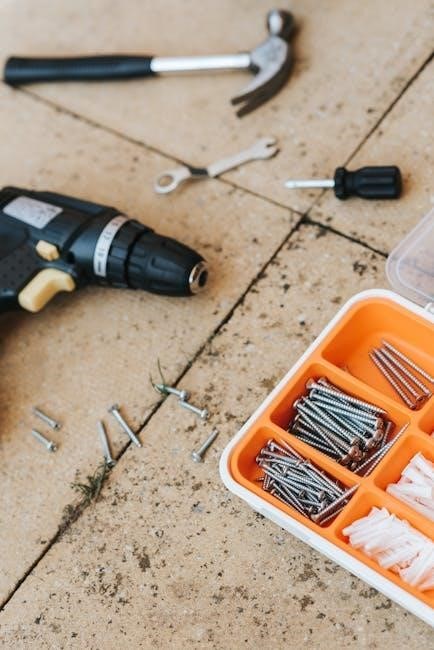The Cessna 172S maintenance manual is a vital resource for ensuring the aircraft’s safety and performance. It provides detailed guidance for routine inspections, repairs, and upgrades, tailored for technicians and owners to maintain the aircraft’s airworthiness and reliability effectively.
1.1 Overview of the Cessna 172S
The Cessna 172S is a widely used single-engine aircraft known for its reliability and versatility. With a wing span of 36 feet, wheel base of 65 inches, and propeller ground clearance of 11.25 inches, it offers stable performance. The aircraft features a wing area of 174 square feet and a minimum turning radius of 27 feet, 5.5 inches. Its normal ground attitude and durable design make it ideal for training and personal use. The Cessna 172S maintenance manual provides detailed guidance for inspections, repairs, and upgrades to ensure optimal safety and performance.
1.2 Importance of the Maintenance Manual
The Cessna 172S maintenance manual is essential for ensuring the aircraft’s airworthiness and safety. It provides detailed procedures for inspections, repairs, and upgrades, helping technicians and owners identify and address potential issues early. Adherence to the manual’s guidelines ensures compliance with regulatory standards, prevents mechanical failures, and extends the aircraft’s lifespan. Regular maintenance, as outlined in the manual, is critical for sustaining performance, safety, and reliability, making it an indispensable resource for anyone involved in the aircraft’s upkeep.
1.3 Purpose of the Manual
The purpose of the Cessna 172S maintenance manual is to provide a comprehensive guide for aircraft technicians and owners. It outlines procedures for routine inspections, troubleshooting, and repairs, ensuring the aircraft remains safe and airworthy. The manual serves as a primary reference for maintaining the aircraft’s systems, addressing potential issues, and performing upgrades; Its detailed instructions are designed to help users comply with regulatory standards and ensure optimal performance, making it an essential tool for anyone involved in the aircraft’s maintenance and operation.

General Information
This section provides essential details about the Cessna 172S aircraft’s specifications, maintenance standards, and reference materials for technicians and owners, ensuring proper maintenance and compliance with aviation regulations.
2.1 Specifications and Dimensions
The Cessna 172S features a wing span of 36 feet 1 inch, a wheel base of 65 inches, and a propeller ground clearance of 11.25 inches. The wing area is 174 square feet, and the minimum turning radius is 27 feet 5.5 inches. These dimensions ensure stability and maneuverability, making the aircraft ideal for training and personal use. The specifications are detailed in the maintenance manual to guide technicians in performing accurate inspections and repairs, ensuring compliance with safety standards and optimal performance.
2.2 Table of Contents
The Cessna 172S maintenance manual includes a detailed table of contents, organizing information for easy access. Sections cover general information, maintenance requirements, service bulletins, airworthiness directives, aircraft systems, structural repairs, engine and propeller maintenance, avionics, electrical system checks, and safety considerations. Each chapter is further divided into subsections, such as routine inspections, lubrication schedules, and repair procedures, ensuring technicians can quickly locate specific guidance. This structure enhances efficiency in maintaining the aircraft’s airworthiness and performance.
2.3 Revision History
The revision history section of the Cessna 172S maintenance manual documents all updates and modifications made to the document. It provides a chronological record of changes, ensuring users are aware of the latest procedures, safety updates, and technical improvements. This section is essential for maintaining compliance with airworthiness standards and reflects the continuous evolution of maintenance practices. Technicians and owners rely on this history to stay informed about critical updates, ensuring the aircraft remains safe and operational.

Maintenance Requirements
The Cessna 172S maintenance requirements outline essential tasks to ensure the aircraft’s safety and performance. Regular inspections, lubrication, and compliance with airworthiness directives are critical for reliability and longevity.
3.1 Routine Inspections
Routine inspections are essential for maintaining the Cessna 172S’s airworthiness. These checks involve examining the aircraft’s exterior and interior for damage, ensuring proper system functionality, and verifying compliance with safety standards. Inspections should be conducted at regular intervals, as outlined in the manual, to identify and address potential issues before they escalate. This proactive approach ensures the aircraft remains safe, reliable, and ready for operation, adhering to both manufacturer recommendations and regulatory requirements.
3.2 Lubrication Schedule
The Cessna 172S maintenance manual outlines a detailed lubrication schedule to ensure optimal engine performance and longevity. Regular lubrication of moving parts, such as the engine, landing gear, and control surfaces, is critical to prevent wear and corrosion. The schedule specifies intervals and recommended lubricants, ensuring compliance with manufacturer standards. Proper adherence to this schedule enhances safety, reduces maintenance costs, and maintains the aircraft’s overall reliability and performance.
3.3 Airworthiness Directives (ADs)
Airworthiness Directives (ADs) are mandatory instructions issued by aviation authorities to address safety concerns or compliance issues. The Cessna 172S maintenance manual highlights specific ADs applicable to the aircraft, ensuring adherence to federal aviation regulations. These directives often require inspections, modifications, or repairs to critical systems, such as engine components or structural elements. Compliance with ADs is essential to maintain airworthiness, prevent potential failures, and ensure the aircraft meets safety standards. Regular reviews of ADs are crucial for ongoing compliance and operational safety. Failure to comply can result in legal consequences and safety risks. Always refer to the latest ADs and service bulletins for updates. Proper documentation of AD compliance is required for maintenance records. Stay informed through official aviation authority notifications and manufacturer updates to ensure all ADs are addressed promptly and correctly. This ensures the aircraft remains safe, reliable, and compliant with all regulations. Regular training for maintenance personnel on AD procedures is also recommended to maintain proficiency and awareness of new or revised directives. By following ADs, operators can mitigate risks, extend aircraft lifespan, and uphold high safety standards. Compliance with ADs is non-negotiable for maintaining airworthiness and public trust in aviation safety.

Service Bulletins
Service bulletins provide updates and recommendations for maintaining the Cessna 172S, addressing inspections, repairs, and upgrades to ensure optimal performance and safety. They are issued by manufacturers to inform owners and technicians of potential improvements or compliance requirements. Regular review of service bulletins is essential for maintaining airworthiness and addressing any emerging issues promptly. Always access the latest bulletins through official channels to stay informed and ensure compliance with safety standards. Proper documentation of completed service bulletins is required for maintenance records. This ensures the aircraft remains safe, reliable, and up-to-date with the latest manufacturer recommendations. Staying proactive with service bulletins helps prevent potential issues and extends the aircraft’s lifespan. By following these guidelines, operators can maintain peak performance and safety standards. Service bulletins are a critical component of ongoing aircraft maintenance and should be integrated into regular maintenance routines. They often include detailed procedures, parts requirements, and compliance deadlines to ensure proper implementation. Regular training for maintenance personnel on service bulletin procedures is also recommended to maintain proficiency and awareness of new or revised recommendations. By adhering to service bulletins, operators can mitigate risks, enhance safety, and ensure the aircraft remains in excellent condition. Compliance with service bulletins is a key aspect of responsible aircraft ownership and operation. Always prioritize service bulletins to maintain the highest standards of safety and performance. This ensures the Cessna 172S continues to operate reliably and efficiently, meeting all regulatory and manufacturer guidelines. Service bulletins are an invaluable resource for maintaining the aircraft’s airworthiness and extending its operational life. They provide clear guidance on necessary actions to ensure the aircraft remains safe and compliant. Regularly reviewing and implementing service bulletins is essential for all Cessna 172S owners and maintenance personnel. This proactive approach helps identify and address potential issues before they become critical. Service bulletins are a cornerstone of effective aircraft maintenance and should be thoroughly understood and applied. By doing so, operators can ensure the Cessna 172S remains a trusted and reliable aircraft for years to come. Service bulletins play a vital role in maintaining the integrity and safety of the Cessna 172S, making them an essential part of any maintenance program; Always stay informed and up-to-date with the latest service bulletins to ensure optimal aircraft performance and safety; This commitment to maintenance excellence is crucial for protecting both the aircraft and its occupants. Service bulletins are a key tool in achieving this goal and should be utilized diligently by all maintenance personnel. By following the recommendations outlined in service bulletins, operators can ensure the Cessna 172S remains in peak condition, ready for safe and efficient flight operations. Service bulletins are an integral part of the maintenance process and should never be overlooked. They provide the necessary guidance to maintain the aircraft’s airworthiness and ensure compliance with safety regulations. Regular review and implementation of service bulletins are essential for all Cessna 172S owners and technicians. This ensures the aircraft continues to meet the highest safety and performance standards. Service bulletins are a critical resource for maintaining the Cessna 172S and should be treated as a priority in any maintenance routine. By staying informed and proactive, operators can ensure the aircraft remains safe, reliable, and compliant with all applicable regulations. Service bulletins are a vital component of responsible aircraft ownership and maintenance, and their importance cannot be overstated. Always make them a central part of your maintenance strategy to ensure the Cessna 172S operates at its best. Service bulletins provide the necessary guidance to maintain the aircraft’s airworthiness and ensure compliance with safety standards. Regularly reviewing and implementing service bulletins is essential for all Cessna 172S owners and maintenance personnel. This proactive approach helps identify and address potential issues before they become critical. Service bulletins are a cornerstone of effective aircraft maintenance and should be thoroughly understood and applied. By doing so, operators can ensure the Cessna 172S remains a trusted and reliable aircraft for years to come. Service bulletins play a vital role in maintaining the integrity and safety of the Cessna 172S, making them an essential part of any maintenance program. Always stay informed and up-to-date with the latest service bulletins to ensure optimal aircraft performance and safety. This commitment to maintenance excellence is crucial for protecting both the aircraft and its occupants. Service bulletins are a key tool in achieving this goal and should be utilized diligently by all maintenance personnel. By following the recommendations outlined in service bulletins, operators can ensure the Cessna 172S remains in peak condition, ready for safe and efficient flight operations. Service bulletins are an integral part of the maintenance process and should never be overlooked. They provide the necessary guidance to maintain the aircraft’s airworthiness and ensure compliance with safety regulations. Regular review and implementation of service bulletins are essential for all Cessna 172S owners and technicians. This ensures the aircraft continues to meet the highest safety and performance standards. Service bulletins are a critical resource for maintaining the Cessna 172S and should be treated as a priority in any maintenance routine. By staying informed and proactive, operators can ensure the aircraft remains safe, reliable, and compliant with all applicable regulations. Service bulletins are a vital component of responsible aircraft ownership and maintenance, and their importance cannot be overstated. Always make them a central part of your maintenance strategy to ensure the Cessna 172S operates at its best.
4.1 Accessing Service Bulletins
Service bulletins for the Cessna 172S can be accessed through official channels, such as Textron Aviation’s website or the Cessna Service Center. Regularly updated, these bulletins are essential for maintenance compliance. Owners and technicians should subscribe to manufacturer notifications to stay informed about new or revised bulletins. Digital archives and online databases provide convenient access to historical and current service bulletins, ensuring timely implementation of safety and performance updates. Always verify the source to avoid unauthorized or outdated information.
4.2 Notable Service Bulletins
Notable service bulletins for the Cessna 172S address critical updates for safety and performance. Examples include fuel pump replacements, electrical system checks, and STC-approved modifications. These bulletins often highlight recurring issues, such as engine performance or avionics upgrades. Technicians should prioritize compliance with these updates to ensure airworthiness. Service bulletins may also include optional enhancements, like the Sportsman’s STOL kit, to improve aircraft capabilities. Regular reviews of these bulletins are essential for maintaining compliance and optimal aircraft operation.

Airworthiness Directives
Airworthiness Directives outline mandatory safety inspections and modifications for the Cessna 172S, ensuring compliance with regulatory standards and addressing critical system performance.
5.1 Understanding ADs
Airworthiness Directives (ADs) are regulatory requirements issued by the Federal Aviation Administration (FAA) to address safety concerns or deficiencies in aircraft design or operation. They mandate specific inspections, modifications, or procedures to ensure the continued airworthiness of the Cessna 172S. Compliance with ADs is legally required and critical for maintaining safety standards. ADs are typically triggered by service history, incident reports, or manufacturer recommendations. They are updated periodically to reflect new safety information or technological advancements. Understanding and adhering to ADs is essential for maintaining the aircraft’s certification and operational integrity.
5.2 List of Applicable ADs
The Cessna 172S is subject to various Airworthiness Directives (ADs) that address specific safety concerns. Key ADs include inspections for fuel pump reliability, engine oil leak detection, and flap track wear. These directives ensure critical systems remain airworthy. Compliance is mandatory, and updates are regularly issued by the FAA. Operators must reference the FAA website or Cessna’s service portal for the latest ADs applicable to their aircraft. Adherence ensures safety and regulatory compliance, with updates often addressing emerging issues or manufacturer recommendations.

Aircraft Systems
The Cessna 172S features an electrical system for power distribution, a fuel system for efficient operation, and a hydraulic and brake system for safe landings, ensuring reliability and safety.
6.1 Electrical System Maintenance
Regular maintenance of the Cessna 172S electrical system is crucial for reliable operation. Check the battery for charge levels and clean terminals to prevent corrosion. Ensure voltage remains stable during engine operation and inspect circuit breakers for proper function. Verify all electrical connections are secure and free from wear. Replace the alternator belt at recommended intervals, typically every 500 hours. Proper maintenance ensures consistent power supply, minimizing the risk of electrical system malfunctions during flight.
6.2 Fuel System Maintenance
Regular fuel system maintenance ensures safe and efficient operation of the Cessna 172S; Inspect fuel tanks for cleanliness and integrity, checking for any signs of corrosion or leaks. Ensure fuel lines and connections are secure and free from damage. The fuel selector valve should be tested for proper function, ensuring smooth fuel flow between tanks. Clean or replace the fuel strainer as needed, and check the electric fuel pump for proper operation. Always follow manufacturer guidelines to maintain system reliability and performance.
6.3 Hydraulic and Brake System
The hydraulic and brake system of the Cessna 172S requires regular inspection to ensure reliable operation. Check for hydraulic fluid leaks, inspect brake lines for damage, and verify proper brake pad condition. Ensure the parking brake functions correctly and adjust as needed. Regular maintenance of these systems is critical for safe landings and ground operations. Always follow the manufacturer’s guidelines for fluid levels, component replacements, and system testing to maintain optimal performance and safety.

Structural Repairs
The Cessna 172S structural repairs involve inspections, skin repairs, and control surface maintenance, ensuring the aircraft’s integrity by adhering to manual guidelines and approved methods.
7.1 Skin Repair Procedures
Skin repair procedures for the Cessna 172S involve assessing damage, cutting access holes, and smoothing edges. Use templates to ensure dimensional accuracy, and flex skin carefully to avoid distortion. After repairs, inspect for proper alignment and rivet securely. Apply sealants as specified to maintain airworthiness. Always follow manual guidelines for materials and techniques to ensure structural integrity and safety.
7.2 Control Surface Maintenance
Control surface maintenance for the Cessna 172S involves regular inspections of flaps, ailerons, and elevators. Ensure all hinges and attachments are secure and properly lubricated. Inspect for signs of wear, corrosion, or damage, and address any issues promptly. Alignment and proper tension of control cables are critical for safe operation. Follow manual guidelines for repair or replacement procedures, and always use approved materials and tools to maintain airworthiness and ensure precise control during flight.
Engine Maintenance
Regular engine maintenance ensures reliability and longevity. Follow manual guidelines for oil changes, cooling system checks, and addressing leaks or wear. Monitor performance metrics and troubleshoot issues promptly to prevent deterioration.
8.1 Oil and Filter Changes
Regular oil and filter changes are critical for maintaining engine health. Use the manual’s recommended oil type and follow the drainage procedure to avoid contamination. Inspect the oil filter for debris and replace it as specified. Proper disposal of used oil and filters is essential for environmental compliance. Always torque the oil drain plug to the recommended specification to prevent engine damage. Keep a log of oil changes to track maintenance history and ensure adherence to the scheduled intervals outlined in the manual.
8.2 Cooling System Maintenance
Regular cooling system checks are essential to prevent overheating and ensure optimal engine performance. Inspect hoses for cracks or leaks and replace as needed. Clean or replace the radiator core to maintain proper airflow. Check the coolant level and mix ratio, ensuring it meets the manual’s specifications. Test the fan operation and ensure all components function correctly. Replace worn or damaged belts and tension them according to the manufacturer’s guidelines to avoid slippage. A well-maintained cooling system guarantees reliable engine operation during all flight conditions.

Propeller Maintenance
Regular propeller inspections ensure safety and optimal performance. Check for damage, wear, and proper pitch settings. Address any issues promptly to maintain efficiency and reliability.
9.1 Propeller Inspection
Regular propeller inspections are critical for maintaining safety and performance. Inspect the blades for nicks, cracks, or erosion. Check the hub for wear or damage. Ensure proper pitch settings and balance. Lubricate the spinner bearing as specified. Look for signs of delamination or corrosion. Verify the propeller’s alignment with the engine. Address any issues promptly to prevent vibration or efficiency loss. Document findings and follow manual guidelines for repairs or adjustments. Regular checks ensure optimal aircraft performance and minimize risks during flight.
9.2 Pitch Adjustment Procedures
Pitch adjustments ensure the propeller operates efficiently at various altitudes and speeds. Start by loosening the pitch nuts slightly. Use a pitch gauge to set the blades to the recommended angle. Tighten the nuts in a star pattern to maintain even tension. Fine-tune the pitch during ground runs at different RPM settings. Ensure compliance with manufacturer specifications. Proper adjustments optimize performance, fuel efficiency, and reduce wear on the engine and propeller system. Always refer to the manual for specific procedures and safety guidelines.
Avionics Maintenance
Regular avionics inspections ensure system functionality and accuracy. Perform routine checks on GPS, navigation, and communication systems. Update software and databases as required. Follow manual guidelines for troubleshooting and repairs.
10.1 Avionics System Inspection
The avionics system inspection involves checking all components for proper function and connectivity. Ensure GPS, navigation, and communication systems are operational. Verify antenna connections and software updates. Inspect wiring for damage or wear. Perform ground tests to confirm system accuracy. Document findings and address any issues promptly. Follow manual procedures for troubleshooting and repairs to maintain reliability and compliance with airworthiness standards. Regular inspections prevent malfunctions and ensure safe flight operations.
10.2 GPS and Navigation Updates
Regular GPS and navigation updates are essential for maintaining accurate flight data. Ensure the system software is current, and all databases are updated. Verify GPS connectivity and performance during pre-flight checks. Follow manual guidelines for installation and verification of updates. Maintain compliance with aviation standards to ensure reliable navigation. Regular updates prevent obsolete data and potential system errors, ensuring safe and precise flight operations. Always refer to the manufacturer’s instructions for specific update procedures and requirements.

Electrical System Checks
Regular electrical system checks are vital to ensure reliable operation. Inspect wiring, circuit breakers, and connectors for wear or damage. Verify proper battery function and charging.
11.1 Battery Maintenance
Proper battery maintenance is essential for reliable electrical system performance. Inspect terminals for corrosion and secure connections. Check electrolyte levels and charge as needed. Ensure the battery is fully charged before storage. Use approved chargers to prevent overcharging, which can damage cells. Clean terminals with a wire brush and apply a protective coating to prevent corrosion. Regularly test battery voltage and capacity to ensure optimal performance. Always follow safety guidelines when handling batteries to avoid injury or electrical hazards.
11.2 Electrical System Troubleshooting
Electrical system troubleshooting involves identifying and resolving issues like power fluctuations or system malfunctions. Start with a visual inspection of fuses, circuit breakers, and wiring for damage or corrosion. Use diagnostic tools to test voltage and continuity. Check connectors and terminals for loose connections. Consult the manual for specific procedures and manufacturer guidelines. Addressing electrical issues promptly ensures system reliability and safety. Always document findings and follow proper repair protocols to maintain airworthiness standards.

Safety Considerations
Adherence to maintenance protocols is crucial for ensuring aircraft safety. Regular inspections and timely repairs prevent system failures. Understanding emergency procedures and proper use of checklists enhances overall safety standards.
12.1 Pre-Flight Inspections
Pre-flight inspections are critical to ensure the Cessna 172S is airworthy. Pilots must check control surfaces, fuel levels, and tire condition. The manual outlines specific steps to follow, including examining the propeller for damage and verifying the integrity of the aircraft’s skin. Proper inspection techniques help identify potential issues before they become safety hazards. A thorough pre-flight routine minimizes risks and ensures a safe flight experience. Regular practice of these procedures is essential for all pilots.
12.2 Emergency Procedures
The Cessna 172S maintenance manual details essential emergency procedures to ensure pilot and passenger safety. These include engine failure protocols, system malfunctions, and emergency landing techniques. Pilots must stay calm and follow established checklists to manage crises effectively. Regular practice of these procedures is crucial to maintain proficiency. The manual emphasizes the importance of knowing emergency protocols to handle unexpected situations confidently and minimize risks. Familiarity with these guidelines is vital for safe operations and quick decision-making during critical moments.
The Cessna 172S maintenance manual is a comprehensive guide ensuring safety and performance. Adherence to its procedures is essential for optimal aircraft reliability and operational integrity.
13.1 Summary of Key Points
The Cessna 172S maintenance manual is a detailed guide for ensuring the aircraft’s safety and performance. It covers routine inspections, structural repairs, engine maintenance, and avionics updates. Adherence to the manual’s procedures is crucial for maintaining airworthiness and operational reliability. The document includes specifications, service bulletins, and airworthiness directives, providing a comprehensive resource for technicians and owners. Regular updates and revisions ensure the manual remains relevant and aligned with industry standards, making it an essential tool for sustainable aircraft maintenance.
13.2 Importance of Adherence
Adhering to the Cessna 172S maintenance manual is critical for ensuring the aircraft’s safety, reliability, and compliance with aviation regulations. Proper maintenance practices prevent mechanical failures, reduce risks, and extend the aircraft’s lifespan. Non-compliance can lead to serious safety hazards, legal issues, and increased maintenance costs. Following the manual’s guidelines ensures that all systems function optimally, providing a secure environment for pilots and passengers. Consistent adherence also supports long-term operational efficiency and maintains the aircraft’s value.
